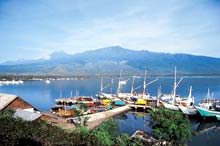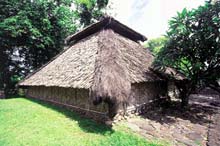CULTURE IN LOMBOK ISLAND
Traditional Culture
Traditional law (adat) is still fundamental to the way of life on Lombok today, particularly customs relating to courting and marriage rituals and circumcision ceremonies. In western Lombok you can see Balinese ceremonies and temples with colorful procession and decorative offerings. Sasak ceremonies are often less visible, though you may see colorful procession as well. Ask around and you can probably find when and where festivals and celebrations are being held.
Circumcision
The laws of Islam require that all boys be circumcised (Nyunatang), and in Indonesia this usually done somewhere between ages of 6 to 11 years old. Much pomp and circumstance mark this occasion on Lombok. The boys are carried through the village streets on painted wooden horses or lions with tails of palm fronds. The circumcision is performed without anesthetic as each boy must be prepared to suffer pain for Allah.
Marriage Rituals
Young couple in Lombok have a choice of three rituals; the first is an arranged marriage, the second a union between cousins, and the third elopement. The first two are uncomplicated: the parents of the prospective bridal couple meet to discuss the bride's dowry and sort out any religious differences. Having handled the business arrangements, the ceremony called "sorong serah" is performed. The third method is far more complicated and dramatic.
Theoretically a young girl is forbidden to marry a man of a lower caste, but this rule can be broken through kidnapping and eloping. As a result, eloping is still a widespread practice on Lombok, despite the fact that in most instances the parents of the couple know what's afoot. Originally it was used as a means of eluding other competitors for the girl's hand or in order to avoid family friction, but it also minimized the heavy expenses of a wedding ceremony. The rules of this ritual are laid down and must be followed step by step. After the girl is spirited away by the boy, he required to report to the Kepala Desa (Chief of the Village). The Kepala Desa then notifies the girl's family through the head of their village. A delegation from the boy's family visits the girl's parent, and between them they settle on a price for the bride, a fine (uang adat) which is distributed among members of the bride's family in recompense for losing her.
Traditional dowries are worked out according to the caste differences; the lower his caste and the higher hers, the more he has to pay. Once this has been settled the wedding begins. Generally the bride and the groom dressed in ceremonial clothes, carried through the village's street, accompanied with sounds of traditional music (gamelan) mingle with the shouts and laughter of the guests as the couple are swooped up and down and around on their way to the wedding place. Throughout the whole ceremony, the bride must look downcast and unhappy at the prospect of leaving her family.
Language
Most people on Lombok Islandare bilingual, speaking their own ethnic language, Sasak, as well as the national language, Bahasa Indonesia, which they have learned at school and use as their formal and official mode of communication. English is becoming more widely spoken on Lombok includes Police and other officials. Travellers without a grasp of Bahasa can get by, but some knowledge of it enhances an understanding of the island and could also be valuable an an emmergency.
Food
In the main Tourist area; Senggigi Island, Gili Islands and Kuta Beach Lombok, numbers of Tourist's Restaurant available serving Western food, Indonesian and Chinese food. In Mataram and in some remote area on Lombok, Indonesian food, Padang food and Chinese food are dominating. Rumah Makan (eating place) can be found easily in Mataram, Ampenan and in most main street. Sasak Food uses white rice as staple, served with vegetable curries or soup, chicken, beef, fishes, hot chilli and no pork. In Bahasa Indonesia, the word Lombok means Chilli paper and it used liberally in local cooking. The famous sasak food are:
Ayam Taliwang, fried or grilled wild young chicken with chilli sauce is originally from Taliwang Sumbawa, but it has become a Lombok speciality.
Sate Ikan Tanjung, one of the tastiest food on Lombok, originally coming from a village called Tanjung - Northern Lombok. Pieces of fresh snapper or tuna mixed with coconut milk, lemongrass, garlic, chilli paper, spices, wrapped onto sate stick and grilled. Try them on your way back from a day tour from waterfall or gili Islands.
Ares, a dish made from the pith of banana tree stem, with coconut juice, garlic and spices.
resource : http://www.lombok-network.com










